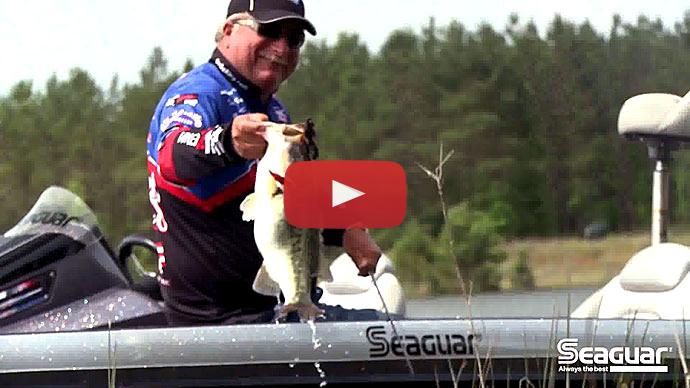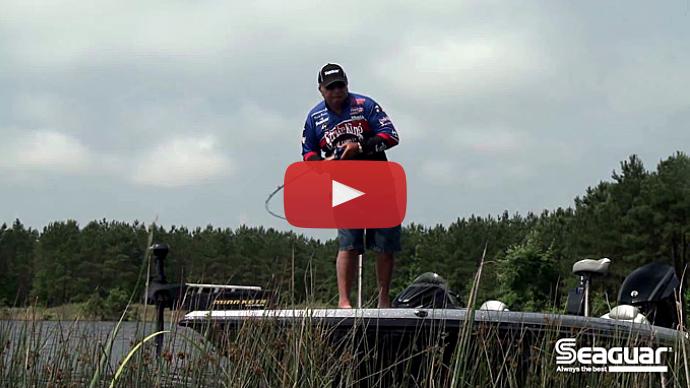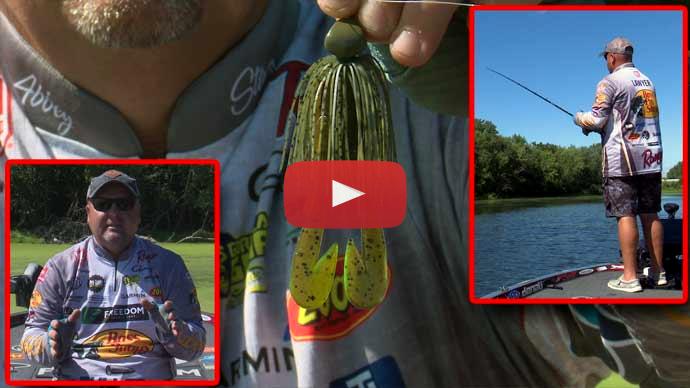All right guys, I'm back again with the Bass Resource and I wanna talk to you about the final stage of flipping, and that's after post spawn, more into the summertime. Now, you can, kind of, bleed those two together depending on the part of the country you're in, but around the Midwest, let's just take a place like Lake of the Ozarks, for instance, and if you can commit to kinda understand that lake, the fish have spawned, there may be a few fry gaurders, the weather's getting warmer, but the fish are now starting to move, like, off onto structure, boat docks are playing really high right now. If you're upper river or the, you know, tributary that you live on doesn't have boat docks, they're gonna be pulling off onto lay down stumps, getting out in open water, starting to school.
But back to Lake of the Ozarks, those fish get on those boat docks, they start making a summertime home, and the only thing you really need to make sure is that you get around the bait. If you're around the bait and you're around the perch, you're gonna get around the bass. You know, you can really upsize your game and your tackle. And this is when I really, really, as a bass fisherman, look forward to being able to take a 7-foot, 10-inch Denali flipping stick and take a 5/8 ounce Freedom Tackle Structure Jig, and this is the Governor color, it's one of my favorite ones.
You know, as we started the spring video off, we talked about being more crawdad, more looking that way, smaller, smaller profiles. They got a little warmer around the spawn. We changed our colors to more of a little bit of a perch, trying to absolutely identically match a perch. And now that we're using a half-ounce weight, well, at this video and this part of time in the spawn, we're gonna go to the 5/8 ounces weight. We're gonna get it to where we can get a reaction bite. We're gonna throw a larger profile jig. We're gonna not trim it near as much.
I like to get really loud with my colors, and then I throw a big trailer, you know. This is where fish are gonna be trying to chase big gizzard shad, even small crappie. You know, they're trying to feed up now. Their spawn is over, they're hungry, they're thin, they're probably in the poorest shape of their life and that means they're the hungriest and the most willing to feed. But if you get a day that's nice and sunny and you get on a stretch of boat docks and you start going down 'em and you notice that you're getting a bite on the windy shady corner, more than likely all the way down through there, that's where the bite's gonna come from when you get one. If they're coming inside the stalls, that's a good, good opportunity to take advantage of that.
In the Midwest, whenever you get a bite, you can duplicate it on the several next boat docks in that same area. So keep that in mind. It's not just your bait, pay close attention to where you got that bite at. You know, if you get a bite and it's inside a whale, there's a good opportunity now that there's two fish in there. More than likely there hasn't really been that way all the way through the spring. There's situations where it happens, but more than likely not. Now, you're gonna be seeing fish group up, something to where a big bait like this is gonna get the biggest fish to bite.
And that makes a big difference as a tournament angler. Now, as a weekend angler, maybe not even interested in a tournament, I know you still wanna catch the biggest fish, now's the greatest time to do that. They may not weigh as much as they did in the spring, but those bigger fish are a little more volatile because they're hungry, they're worn out, they're ready to feed up.
So what I'm gonna do here, I took this Freedom Structure Jig out of the package, I'm not gonna do a lot to it. You can see there it's about an inch below the hook. I am gonna trim that just a little bit, and I'm kind of doing it a little bit irregular. I don't want it to all be the same, but I want it to be just a little bit. You can see there it's pretty irregular. It’s not like we just cut a seam there.
Then I'm gonna take my trailer here of choice. You can use a full Zoom Z Craw, you can use a brush hog, you can use whatever your favorite bait is, but I'm not gonna bite any off of that. I'm just gonna put it on there and push it all the way up on the bait. And now you can tell there, that's a larger profile bait, you know, considering what we have been but the perch are bigger, the bass are more aggressive to eat that bigger bait.
And what I like to do is use this heavier head in the 5/8 model because of that. Your fall rate's gonna be slower. I'm throwing 25 pound Sunline Shooter on there, that's gonna make it fall a little bit slower. So it's just a few things you've got are, kind of, against you a little bit as far as your fall rate, and I want to keep that fall rate as fast as possible. Now's the best time since you've started flipping in the spring to really get a good reaction bite, and so keep that in mind.
You know, the second thing that I'm definitely gonna try and think about whenever I'm doing this is what the fish are gonna be on. More than likely, those places were up on the bank. They’ve been in two foot of water last, three foot spawning, and that's probably over with. You're probably gonna have to key on things that are off the bank just a little bit. You know that, 5 to 10, 5 to 8 foot of water is gonna come into play a lot more. You know, the shadiest part of the boat dock, the darkest part, the biggest part of the laydown, whatever it might be, I feel like that's where you wanna make your first flip. You're not really fishing slow either. You're wanting to put it in there, shake it, swim it, you know, you're trying to get him to know it's there. And the fish will kind of help you out a little bit right now because the fact that they're aggressive, they're tired from the spawn.
So the second thing that I'm gonna pay attention to is how many more fish are still up there in that area. You know, they have a tendency to actually wanna move out and start thinking about getting on the bottom on structure out off the lake, brush piles, humps, different things. I take this same jig, that's why it's called a structure jig and throw it right out there. Now, I might lighten my lineup a little bit. I may go to 17 or 20 FC Sniper, I may stay with Shooter. Kinda depends on my water clarity and exactly how deep it is and then how much structure there's actually I gotta fish through out there.
And one thing that I've kinda learned that that's, kind of, when your old big worm is gonna start coming into play, I like to throw a big worm on structure when the fish will let me, because there's two reasons. I think your hookup ratio's a little bit better on a big worm because it's soft and they commit to trying to eat it a little bit better. And then secondly, there's no doubt a big worm comes through cover any better than any other bait out there, you know. And this is just your simple Texas rig worm, 3/8 ounce sinker, 5/0 Superline Gamakastu Hook, and that's a Zoom 'Ol Monster and Tequila Sunrise, you know.
And I like to rig this a little bit different. Now it's flat on the back and ribbed on three sides, but I don't rig it on the flat back side. You can see here in the tail it's got a flat side on this one and then it's all curved and rickety on that side. That is the side that the tail is actually poured from. So I like to have my hook in line with that, from there to there. You can see that's the side that is poured from.
Now this bottom, I believe, right here is actually how that hook was meant to be put into the bait but a bass can't tell that that's not ribbed on that side. And plus, I like the fact that your hook hides in one of them little ribs up there on top. You can see there, that's just slick as a whistle, blends right in. But I like the idea that the tail is not laying this away from the weight of the hook. It is gonna lay exactly in line with the hook as a belly weight. If it laid on its belly like that, how they intended to pour the bait, then it'd be different.
So just something I do a little bit different, but I'm still throwing it on the same setup. I'm either gonna throw it on a 7/6 Denali or a 7/10. If I'm pitching close to me and I'm just, kind of, utilizing more than the flipping application, I'm gonna throw the 7/10. If I get to where I'm casting, this is a 7/6 Denali flipping stick, I'm gonna cast with it just a little bit out there. But I like it because I get the backbone of when I set the hook, I turn the fish towards me, maybe getting coming up out of that brush pile.
And so there's really just two applications, but this is where your offshore stuff's gonna start working. It might even be a Carolina rig. It may roll right out into a big crankbait, your flipping's gonna, kind of, go away and everything's gonna start being off the bank structure fishing, you know, post spawn, full blown.
So keep that in mind. But as these fish transition, there's definitely gonna be, you know, several weeks, depending on your part of the country, that they're gonna be super shallow coming in, several weeks spawning and several weeks leaving. So just because the spawn's over, don't be afraid to still get in those same areas maybe where you saw a bunch of spawning fish and try to utilize it flipping and pitching a worm around, imitating either just something feeding on the bottom or a perch and get those extra bites that sometimes somebody overlooks.



